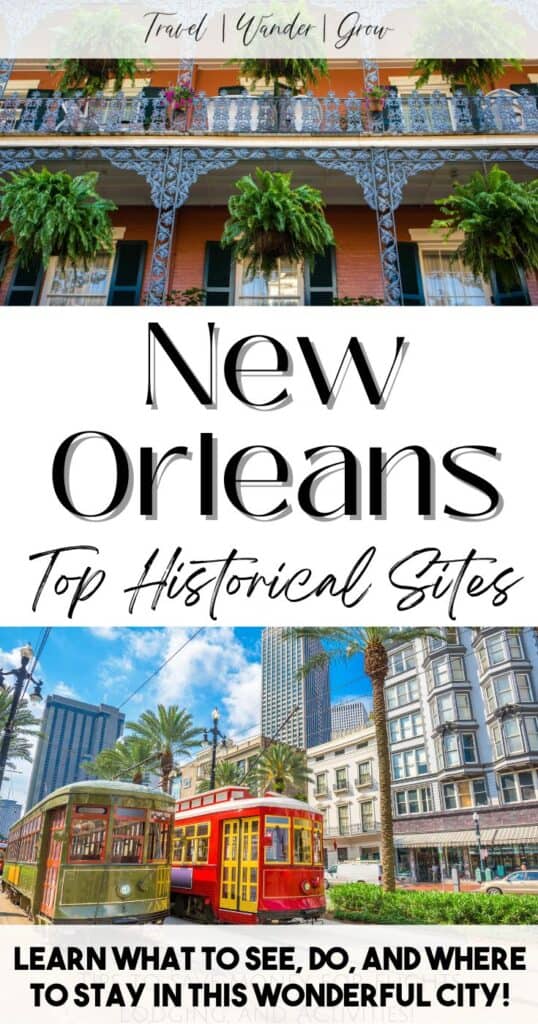The Top 15 Historical Sites in New Orleans
So, you’re a history buff, and New Orleans is next on your list? Great choice! Your adventure through the Historical Sites in New Orleans starts right here. Trust me, this city is like a living history book. “The Big Easy” should be on your United States bucket list. It mixes Native American roots, French flair, Spanish influences, and African heritage.
This comprehensive guide dives deep into the top 15 Historical Sites in New Orleans, looking at each landmark’s unique history and significance and including tips for exploring.
Prepare to journey through iconic locations like famous buildings in New Orleans, the St. Louis Cathedral, the New Orleans Jazz Museum, and the mysterious Lalaurie Mansion. I’ll share some of my top tips for visiting New Orleans as well. I have no doubt that you’ll clearly be able to see why this is one of my favorite cities in the US after reading this post.
The Top 15 Historical Sites in New Orleans
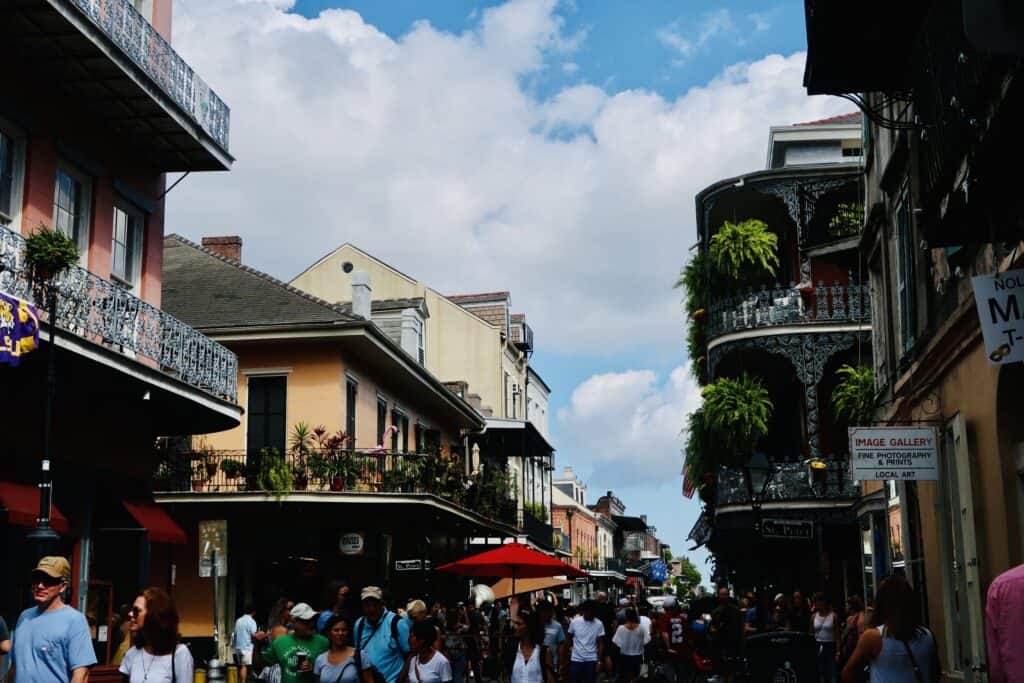
1 | French Quarter
Also known as Vieux Carré, the French Quarter is New Orleans’ oldest neighborhood. Established by French colonists in 1718, this area is a living testament to the city’s rich history. Some of the oldest buildings include the Ursuline Convent, built in 1752, and the Lafitte’s Blacksmith Shop, dating back to between 1722 and 1732. The area is a labyrinth of historic streets, with Royal Street, Bourbon Street, and Chartres Street, making this place one of the most famous New Orleans landmarks.
Visiting the French Quarter
When you visit the French Quarter today, you’ll find a bustling area filled with live music, street performers, and various dining options. For instance, you can munch on beignets at the famous Café du Monde, catch some live jazz at Preservation Hall, or hunt for treasures in the antique shops and art spots on Royal Street. The buildings? They’re a fantastic mash-up of Spanish, French, and American designs that’ll catch your eye.
Tips for visiting the French Quarter: Wear comfortable shoes. The area is best explored on foot, and you’ll want to wander down famous streets like Bourbon and Royal. I also recommend that you explore this area during the day time, and consider taking a tour. It gets quite rowdy in this area at night – I’d recommend you spend your time catching a live Jazz show in Frenchman’s quarter instead. (This is my favorite part of the city).
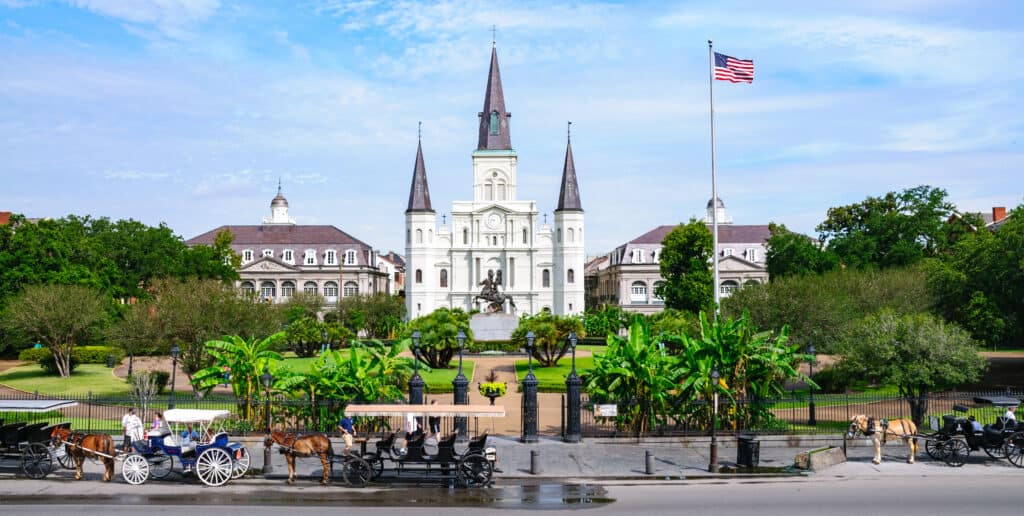
2 | St. Louis Cathedral
St. Louis Cathedral, originally built in 1789, is the oldest continuously active Roman Catholic cathedral in the United States. It’s one of the most important historical landmarks in New Orleans that has witnessed countless events. The cathedral has survived two major fires and has been rebuilt and expanded multiple times. It’s named after King Louis IX of France, who was canonized as a saint. The cathedral has three spires, with the central spire towering at 185 feet, making it a prominent feature of the New Orleans skyline.
Visiting the St. Louis Cathedral
The cathedral remains an active church and a must-visit historical site. Tourists can explore its stunning architecture, which includes intricate stained glass windows and a 6,000-pipe organ. The church also occasionally hosts free classical music concerts, offering a unique blend of spiritual and cultural experiences. The adjacent Jackson Square and the statue of Andrew Jackson provide excellent photo opportunities. Visitors can attend mass, light a candle, or sit in the pews to soak in the peaceful ambiance.
Tip for visiting the St. Louis Cathedral: Don’t miss the free guided tours to learn about the cathedral’s history and architecture.
3 | Jackson Square
Jackson Square is one of the most significant historical sites in New Orleans, a critical spot that’s been around since the 1700s. Named after Andrew Jackson, noted for efforts during the Battle of New Orleans, this square has seen a lot. It’s been busy for centuries, from public markets to military parades. This is also where the aforementioned St. Louis Cathedral can be found.
Visiting Jackson Square
When you visit Jackson Square now, you’ll find it’s a lively place to be. Artists set up their easels to paint and sketch while musicians play tunes that make you want to dance. Adding to its charm, the square is encircled by historic structures, including the St. Louis Cathedral. You can also ride the carriage around the square to learn more about its history. It’s a snapshot of New Orleans life, past and present.
Tip for visiting Jackson Square: Bring cash for the street performers and artists; they make the square special.
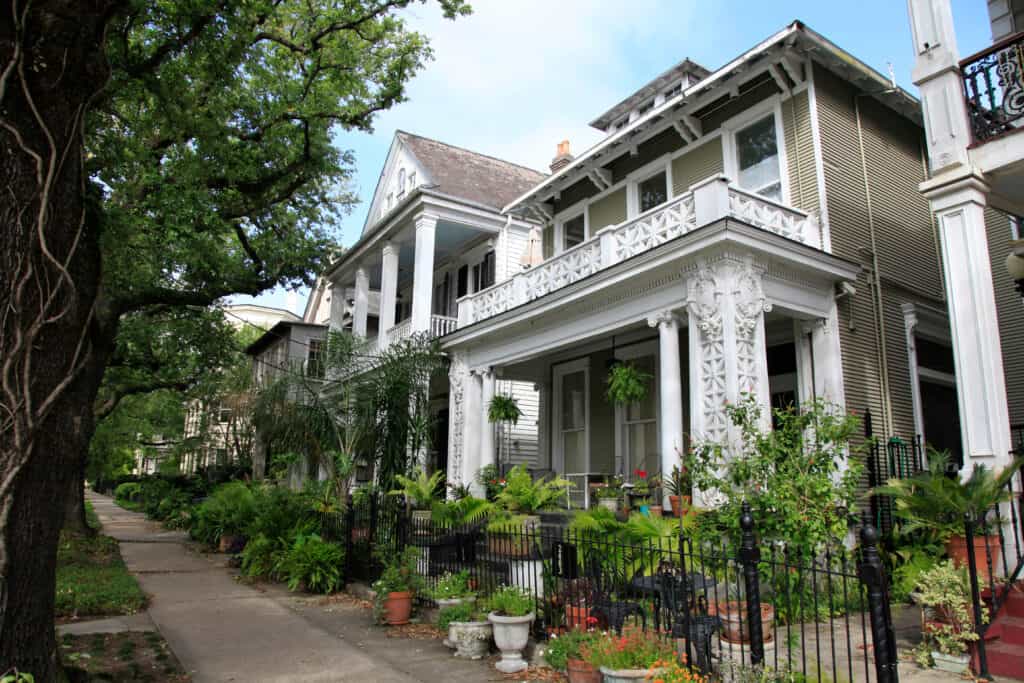
4 | Garden District
The Garden District is a special part of New Orleans that takes you back in time. It was set up between 1832 and 1900, mainly for rich Americans who didn’t want to live near the Europeans in the French Quarter. This area is famous for its big, old homes, making it a must-see historical site in New Orleans. These grand homes are on streets like Magazine Street and Prytania Street.
Visiting the Garden District
Walking through the Garden District is like taking a calm break from the busy French Quarter. You can enjoy a slow walk and see homes with lovely gardens full of big trees. Also, the area has the well-known Lafayette Cemetery No. 1. Here, you can take a short guided tour to learn about how people in New Orleans bury their loved ones above ground. If you tire, you can stop at cute shops and cafes on Magazine Street. It’s a part of New Orleans that gives you a mix of history and modern-day fun.
Tip for visiting the Garden District: Take a guided walking tour to fully appreciate this beautiful area’s history and architecture.
5 | New Orleans Jazz Museum
The New Orleans Jazz Museum is an excellent spot that celebrates the city as the birthplace of jazz. This music style started in New Orleans in the early 20th century, blending African rhythms, blues, and ragtime. Big names like Louis Armstrong, Jelly Roll Morton, and Sidney Bechet started their careers here, making the city a true jazz hub. The museum is in the Old U.S. Mint, a building that’s been around since the 1800s. It’s packed with stuff that tells the jazz story, from old instruments to sheet music.
Visiting the New Orleans Jazz Museum
When you visit, you’ll find lots of exciting things. You can see old trumpets and saxophones that jazz legends once played. There’s also sheet music that shows how classic jazz songs were written. If you like hands-on stuff, there are interactive exhibits where you can make your own music.
Tip for visiting the New Orleans Jazz Museum: Check the museum’s schedule for live performances; they often have events that bring the exhibits to life.
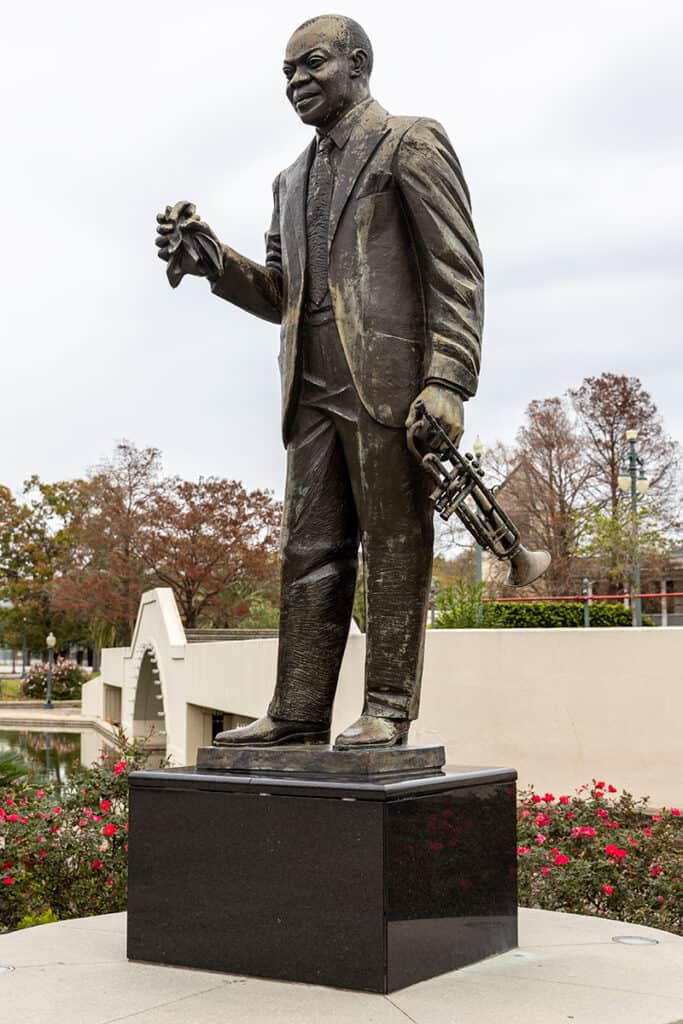
6 | Louis Armstrong Park
Louis Armstrong Park is a special place that honors the great jazz musician Louis Armstrong. He was born in New Orleans, and this park celebrates his fantastic impact on music. The park is in the Treme neighborhood, one of the oldest African-American areas in the U.S. It’s an essential spot if you’re interested in the city’s rich musical history.
Visiting the Louis Armstrong Park
When you visit the park, you’ll find it’s a peaceful place to hang out. Some statues and plaques tell you about Louis Armstrong and other music legends. The park often hosts live music events so that you might catch a free concert. Another great spot in the park is Congo Square, a historic area where enslaved people and free people of color used to gather. It’s a place that mixes history, music, and natural beauty, making it a must-visit spot in New Orleans.
Tip for visiting Louis Armstrong Park: Local artists and musicians often perform in the park on weekends.
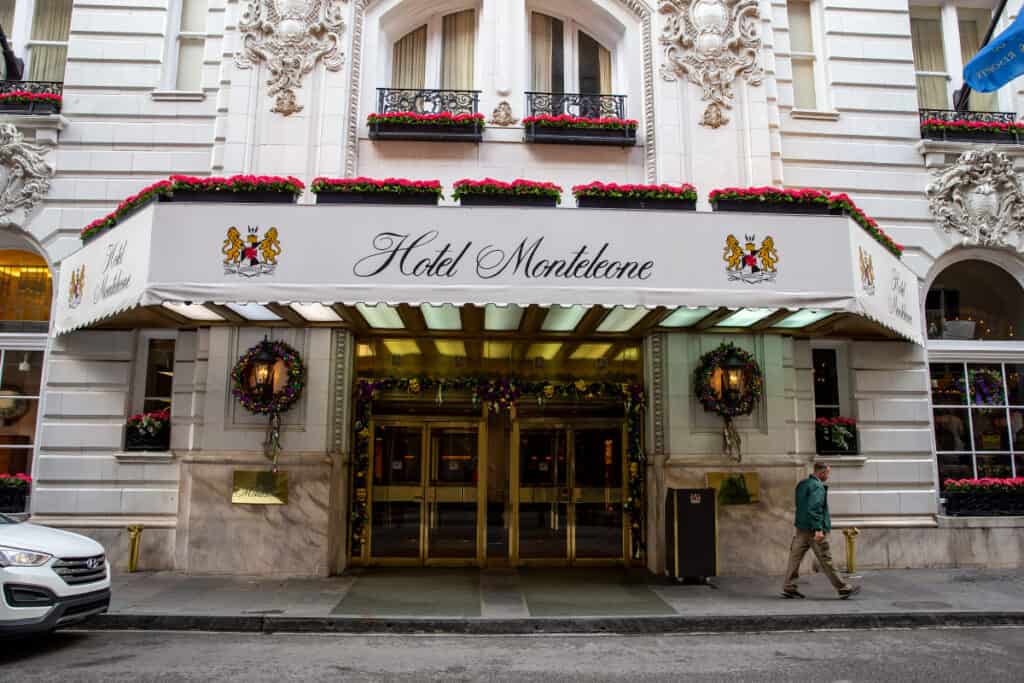
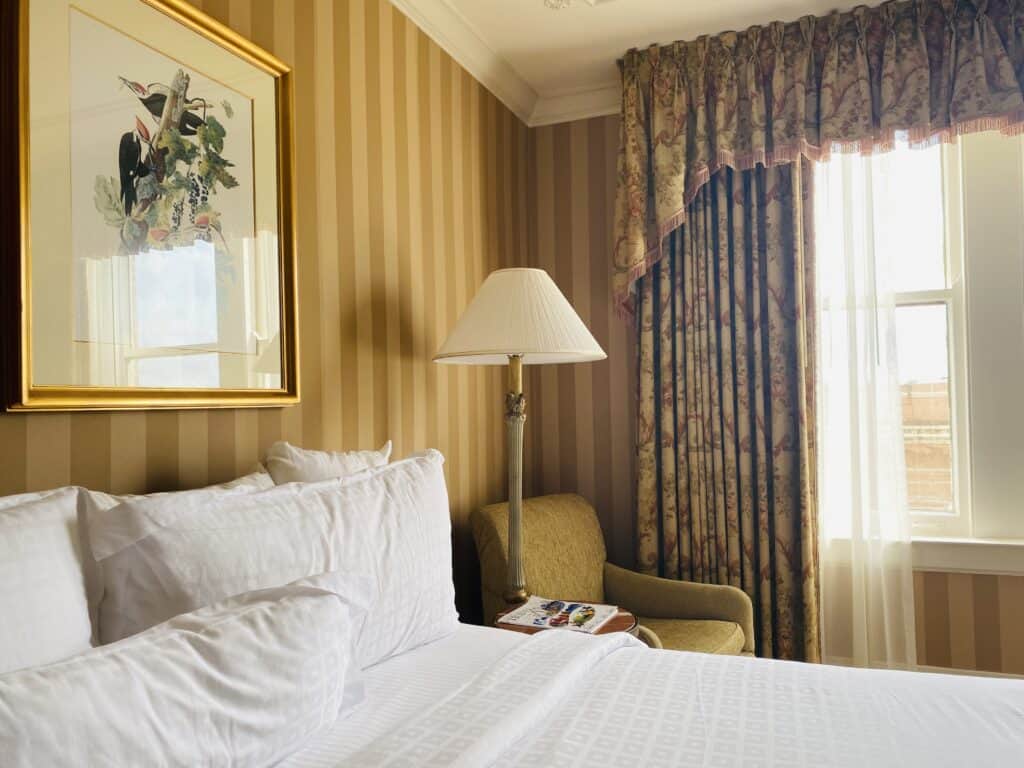
7 | Hotel Monteleone
Hotel Monteleone is more than just a place to stay; it’s a piece of New Orleans history. Opened in 1886, this hotel has been family-owned for five generations. It’s one of the few remaining historic hotels in the city, making it a famous landmark in New Orleans. Over the years, it’s hosted celebrities, politicians, and even famous writers like Ernest Hemingway.
I actually stayed in this hotel on my last visit to New Orleans and found it to be incredibly charming. If you like hotels that have a lot of class and a good story, this is certainly the place for you.
Visiting & Staying at Hotel Monteleone
Walking into Hotel Monteleone today, you’ll feel like you’ve returned in time. The lobby is grand, with chandeliers and marble floors. One of the coolest things is the Carousel Bar, a rotating bar that’s been around for over 65 years. It’s a fun spot to grab a drink and soak in the hotel’s rich history. The hotel also has a rooftop pool with a great city view. It’s not just a hotel; it’s an experience that gives you a taste of old New Orleans.
Tip for visiting Hotel Monteleone: Make sure to visit the Carousel Bar; it’s a unique experience you won’t want to miss. If you’d like to stay here, click here to book!
8 | Beauregard-Keyes House
The Beauregard-Keyes House is a gem that takes you back to the 1800s. Built-in 1826, this house is named after two of its most famous residents: Confederate General P.G.T. Beauregard and author Frances Parkinson Keyes. It’s a place that tells stories of war, love, and literature, making it a unique historical site in New Orleans.
Visiting the Beauregard-Keyes House
When you visit, you’ll get to see how people lived back in the day. The house is filled with old furniture, artwork, and even some of the general’s war memorabilia. They offer guided tours that tell you all about the people who lived here and the times they lived in. The garden out back is a quiet spot, perfect for taking a break and soaking in the history.
Tip for visiting the Beauregard-Keyes House: The garden is a hidden gem; make sure to spend some time there.
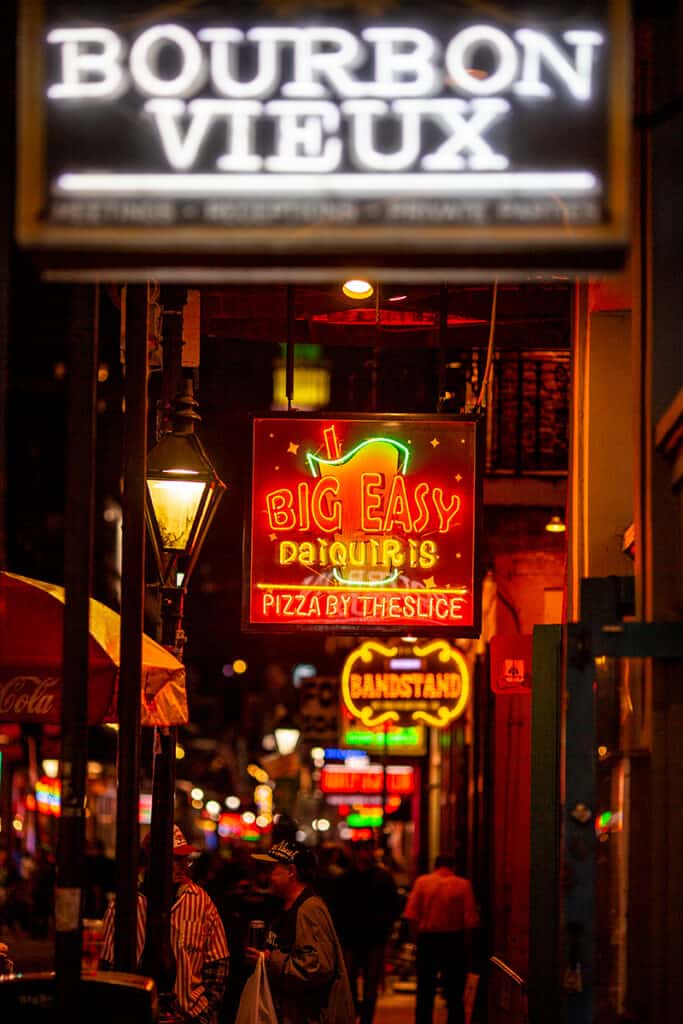
9 | Bourbon Street
Bourbon Street is the heart of New Orleans’ nightlife and a place that’s always buzzing. Named after the French royal family, this street has been a hotspot since the 1700s. Over the years, it’s seen everything from jazz clubs to speakeasies. It’s a famous landmark in New Orleans that shows the city’s love for good times and great music.
Bourbon Street Today
If you walk down Bourbon Street today, you’ll immediately feel the energy. It’s packed with bars, clubs, and restaurants that offer something for everyone. You can listen to live jazz, try the local drink called a “Hurricane,” or enjoy some good old people-watching. Street performers often set up shop, adding to the lively atmosphere. And if you’re into history, many bars have plaques that tell you about their past. It’s more than just a street; it’s a New Orleans experience you won’t want to miss.
Tip for visiting Bourbon Street: It gets crowded in the evenings, so if you prefer a quieter experience, try visiting in the daytime.
10 | Lalaurie Mansion
The Lalaurie Mansion is one of the most talked-about places and iconic buildings in New Orleans, but not for the usual reasons. Built-in 1832, this mansion was home to Delphine Lalaurie, a socialite with a dark secret. She mistreated her slaves terribly, and the house is said to be haunted because of it. This famous building in New Orleans shows a darker side of the city’s history.
Visiting Lalaurie Mansion
These days, the Lalaurie Mansion is a private residence, but it still draws a crowd. People often stop by to take pictures and hear about its spooky past. It’s even been featured in shows like “American Horror Story.” While you can’t go inside, many ghost tours in the city will take you by the mansion and share its chilling tales. It’s not just a house; it’s a lesson in the darker chapters of New Orleans’ past. I did a ghost tour that included this mansion on a recent visit to New Orleans – and let me tell you, I was properly spooked!
Tip for visiting Lalaurie Mansion: This is a popular stop on many ghost tours if you’re interested in the spookier side of New Orleans history.
11 | Lafitte’s Blacksmith Shop
Lafitte’s Blacksmith Shop is more than just a catchy name; it’s one of the oldest bars in the U.S., dating back to the 1700s. Named after the pirate Jean Lafitte, this place has a rich history filled with tales of smuggling and secret meetings. It’s a famous landmark in New Orleans that gives you a taste of the city’s colorful past.
Visiting Lafitte’s Blacksmith Shop
When you step into Lafitte’s today, you’ll feel like you’ve traveled back in time. The bar is dimly lit, mostly by candles, adding to its old-world charm. Like their famous “Purple Drank,” you can enjoy a drink while listening to live piano music. Whether you’re a history buff or just looking for a unique place to hang out, Lafitte’s is a must-visit in New Orleans.
Tip for visiting Lafitte’s Blacksmith Shop: Try the “Purple Drank,” a house specialty, but be cautious—it’s stronger than it looks!
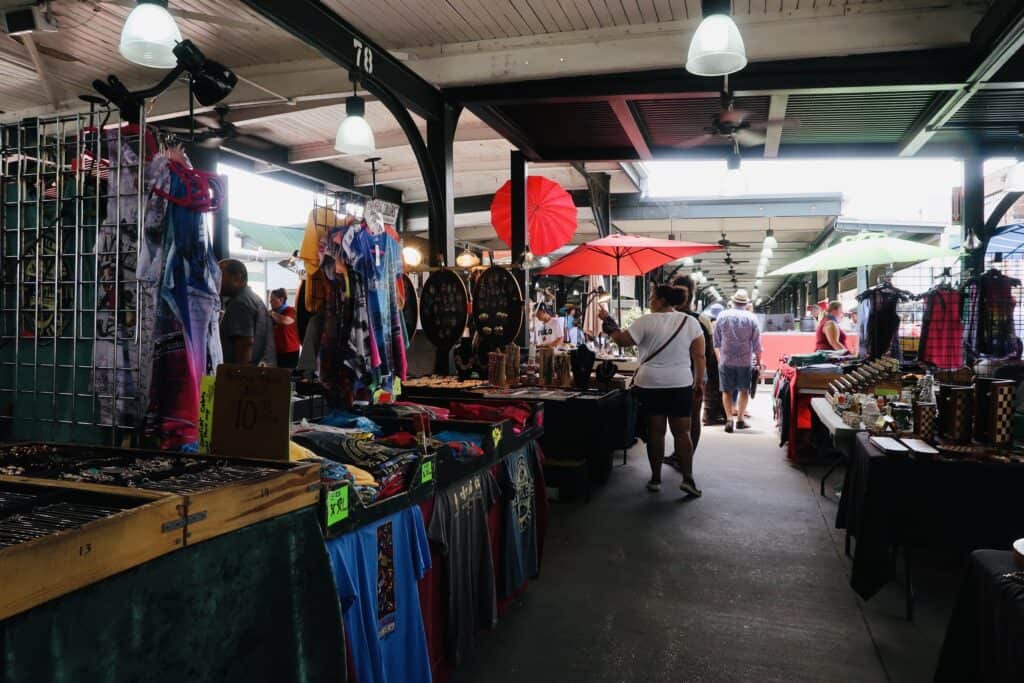
12 | French Market
The French Market is a bustling spot that’s been around for over 200 years. It started as a Native American trading post before New Orleans was a city. Over time, it became a place where you could find all sorts of things, from food to crafts. Today, it’s a famous New Orleans landmark showing the city’s love for commerce and community.
Visiting the French Market
When you visit the French Market, you’ll find it’s a shopper’s paradise. You can buy fresh produce, local crafts, and even unique souvenirs. Food stalls offer tasty bites like beignets and jambalaya, giving you a flavor of New Orleans. Street musicians often play nearby, adding to the lively atmosphere.
Tips for visiting the French Market: Go with an empty stomach; there are many delicious local foods to try. I also recommend pickup up a fan that you can use to keep yourself cool – particularly in the very hot summer months.
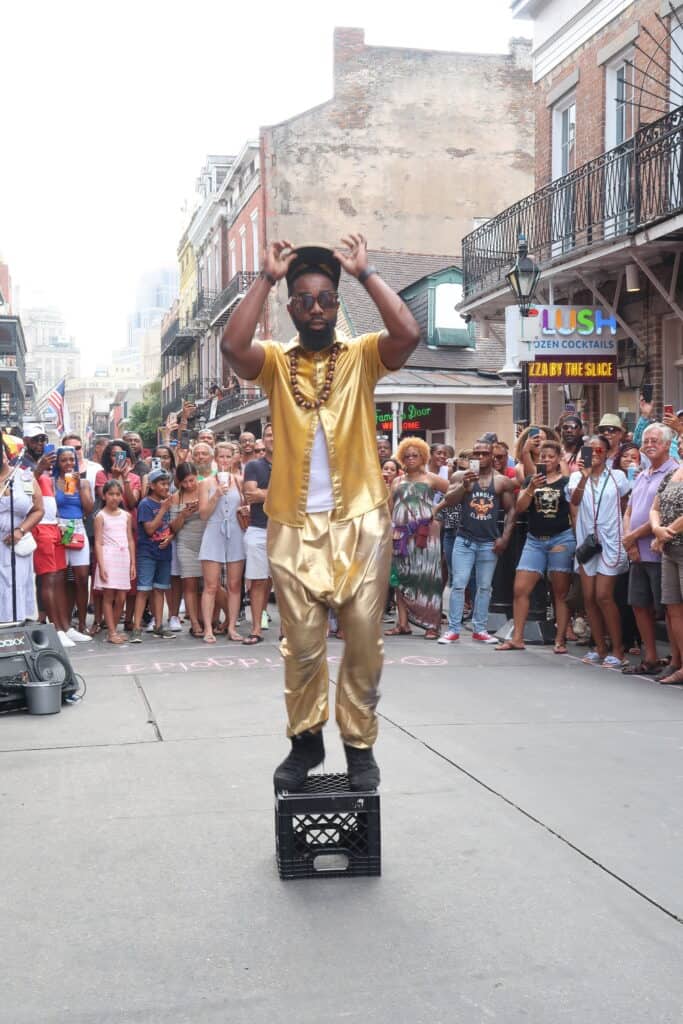
13 | Old Ursuline Convent Museum
The Old Ursuline Convent Museum is a place that takes you way back. Built in 1752, it’s the oldest structure in the Mississippi Valley. The Ursuline nuns who lived here played a significant role in the city’s early years, from healthcare to education. Today, it’s a historical landmark in New Orleans that tells a story of faith and service.
Visiting the Old Ursuline Convent Museum
When you visit now, you’ll find the convent turned into a museum that’s full of exciting stuff. You can see old religious artifacts, letters, and even the nuns’ living quarters. Guided tours are available to tell you about the history and the people who made this place special. It’s a place that lets you step back in time and learn about New Orleans’ early days.
Tip for visiting Old Ursuline Convent: The guided tours are highly informative and worth the extra cost.
14 | Mardi Gras World
Mardi Gras World is a one-of-a-kind place that dives deep into the magic of the yearly New Orleans Mardi Gras festival. Blaine Kern Studios, a big name in float building, created the spot. It’s a place that shows you the behind-the-scenes action of this huge event, making it a unique historical site in New Orleans.
When I visited this site, I was amazed by all of the floats. They have all themes here, and it’s really cool to get a “peak behind the curtain” of what goes on in prep for Mardi Gras.
Mardi Gras World Today
When you visit, you’ll get a front-row seat to how Mardi Gras comes to life. You can see artists working on the Mardi Gras floats, each more colorful than the last. There are also costumes and props on display, giving you a complete picture of what goes into the parade. Tours are available, and they even let you try on some costumes for fun photos.
Tip for visiting Mardi Gras World: Don’t forget your camera; the photo opportunities are endless.
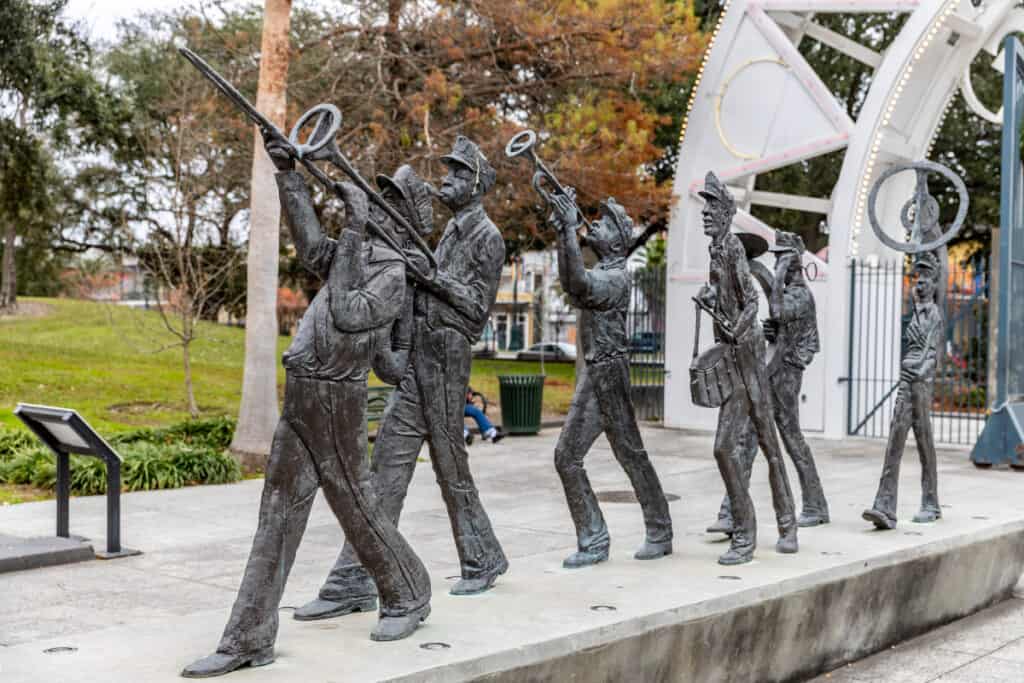
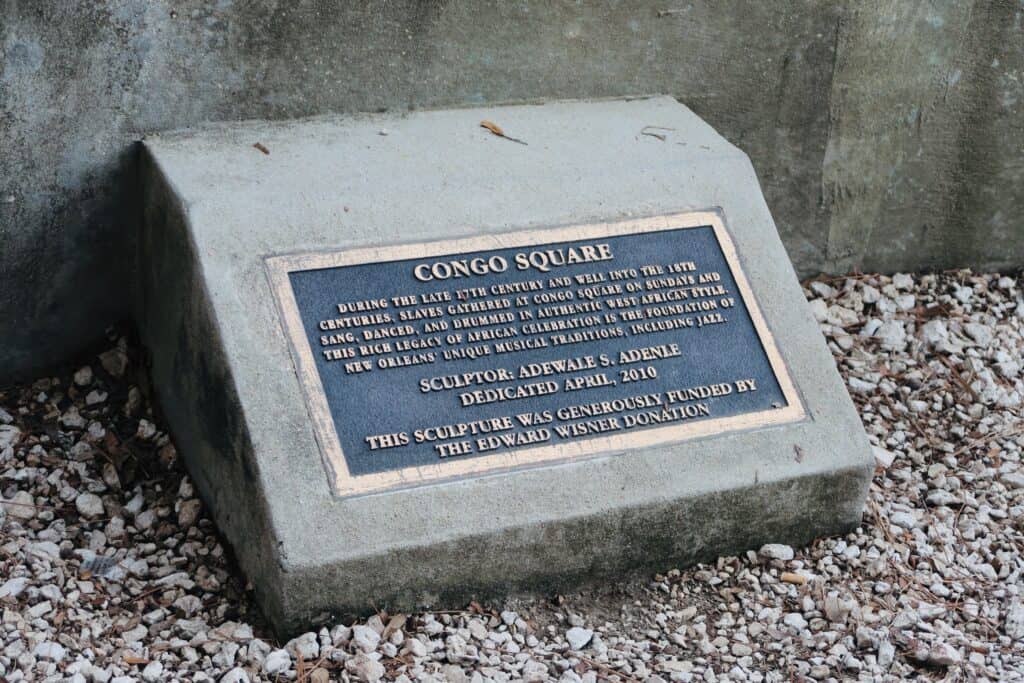
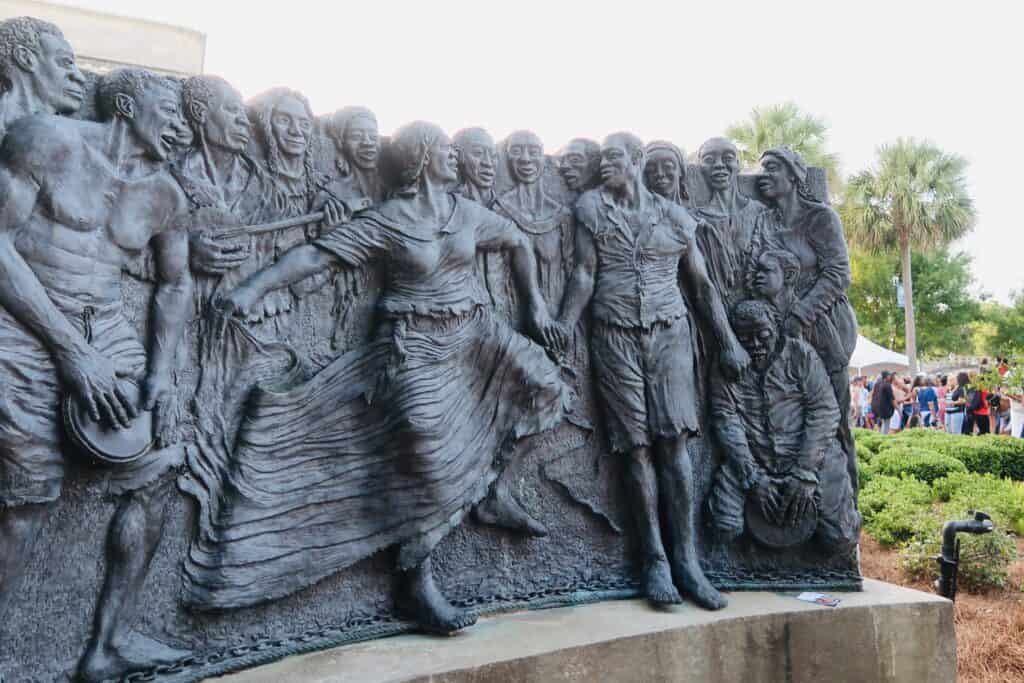
15 | Congo Square
Congo Square is a place that holds a particular spot in New Orleans’ history. Located in what is now Louis Armstrong Park, this square was once the gathering spot for enslaved people and free people of color on Sundays. They would come to dance, sing, and celebrate their African heritage. Today, it’s a famous landmark in New Orleans that serves as a reminder of the city’s complex past.
Congo Square Today
When you visit Congo Square now, you’ll find it’s a place that still celebrates culture and community. Events and festivals often feature music that traces back to African and Caribbean roots. It’s a spot where you can simultaneously feel the city’s soul and learn about its history. Whether it’s a drum circle or a jazz festival, something often happens that makes it worth a visit.
Tips for visiting Congo Square: Check the local events calendar; you can catch a live performance or festival.
A Brief History of New Orleans
History of the Land
New Orleans is like a hearty gumbo of history and culture. Imagine a place where Native American, French, Spanish, and African traditions all mix together. Before colonialization, New Orleans was home to the Mississippian culture for about 1300 years. One of the original names of New Orleans was Bulbancha, which means “place of many tongues”. It was called this because the area was a major trading hub for the various Native American cultures that lived here. The peoples that lived here built mounds and earthworks in the area, and there is archaalogical evidence of settlement since at least 400 B.C.
French and Spanish Colonization
The French were the first Europeans to arrive in the area, with fur trappers and traders arriving in the 1690’s. Not too long afterward Jean-Baptiste Le Moyne de Bienville and his French company officially claimed the area in 1718. They named the city La Nourvelle-Orléans, after the Duke of Orleans, who was basically the big boss in France at the time. These early settlers knew they hit the jackpot with this location. It was perfect for keeping an eye on their territory and for trading goods, thanks to the nearby Mississippi River and Gulf of Mexico.

Spanish colonization in New Orleans, which occurred from 1763 to 1803, left a profound impact on the city’s cultural, social, and architectural landscape. The Spanish administration instituted reforms that shaped New Orleans’ distinctive Creole identity. Architecturally, after a devastating fire in 1788, the city was rebuilt in a Spanish style, leading to the iconic Spanish Colonial houses that are a staple of the New Orleans aesthetic today.
Slavery in New Orleans
Along with colonization came slavery, like the rest of the area at the time. The French introduced the “Code Noir” or “Black Code” in 1724 which dictated the treatment of slaves in the area. This legal framework allowed for horrifyingly brutal treatment of enslaved people, including physical punishment and execution.
Furthermore, the Spanish period saw the growth of the free people of color population, as Spanish laws were more lenient towards manumission than French ones. Despite being a period of less than half a century, Spanish rule significantly influenced the unique cultural melange that defines New Orleans today.
Slavery in New Orleans was uniquely distinct from other parts of the United States, largely due to its multicultural composition and the influence of French and Spanish colonial rule. Unlike the strict racial divide prevalent in other American regions, a tripartite social order existed in New Orleans, composed of whites, free people of color, and slaves. This led to the emergence of a sizable and influential community of free people of color, a rarity in other slave-holding states.
Furthermore, the Code Noir’s provision for religious education led to the Catholic baptism of many slaves, which was not a common practice elsewhere in Protestant-dominated America. This unique sociocultural milieu shaped a slave society in New Orleans that was markedly different from the rest of the United States. Read: Different, but not better. You can catch a glimpse of this time in the many plantation homes that are still in the area. Today, some of these New Orleans plantations serve as museums, offering a sobering look at this dark period.
Louisiana Purchase
After Spanish rule, New Orleans returned to French rule from 1802 to 1803. In April 1803, Napoleon sold “New France” to the US in what is known as the Louisiana Purchase. This sale doubled the size of the United States and ended the rule of European nations in what is not the continental US. This purchase includes interesting flora and fauna, such as the Mississippi River and the Louisiana Swamps.
Mississippi River
The Mississippi River is more than just a waterway; it’s the heartbeat of New Orleans. It has been a major trade route since the city’s early days, shaping its economic and cultural landscape. The river’s importance even influenced the city’s unique crescent shape, earning it the nickname “The Crescent City.” Beyond commerce, the river has inspired countless artists, musicians, and writers.
Louisiana Swamps
New Orleans’ unique geography adds another layer to its rich history. Louisiana Bayou swamps surround the city and offer a different kind of historical and cultural experience. These wetlands are home to diverse flora and fauna, including mossy trees, alligators, and herons. Various tours allow visitors to explore this unique ecosystem.
Recent History & New Orleans Today
In recent history, New Orleans faced one of its most significant challenges with Hurricane Katrina in 2005. The devastating hurricane resulted in severe flooding, causing colossal damage to houses and infrastructure, and tragically resulting in the loss of over 1,800 lives. Katrina highlighted the city’s vulnerability to natural disasters and the pressing need for comprehensive disaster management systems.
In the years following Katrina, New Orleans has shown remarkable resilience and spirit in rebuilding the city and restoring its unique cultural vibrancy. Today, New Orleans is a bustling city renowned for its rich blend of cultures, music scenes, and world-class cuisine. Although it still grapples with the challenges of urban development and environmental sustainability, the city is still a remarkable one, and one that you should certainly visit!
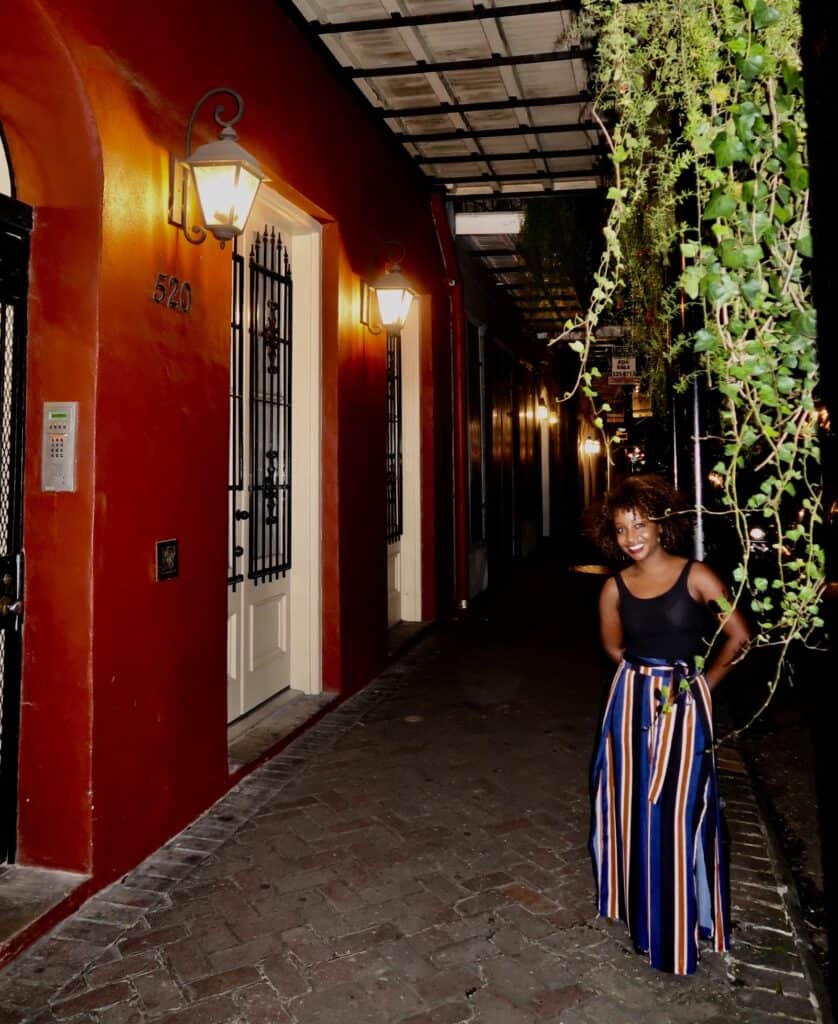
FAQs | Historical Sites in New Orleans
The French Quarter is often considered the most historical place in New Orleans. It’s the oldest neighborhood in the city and is filled with historic buildings, some dating back to the 18th century.
New Orleans is known for its rich cultural heritage, influenced by French, Spanish, African, and Native American cultures. It’s also famous for being the birthplace of jazz, its role in the Louisiana Purchase, and its unique Mardi Gras celebrations.
Lafitte’s Blacksmith Shop Bar is famous for having no electric lights. The bar is lit primarily by candles, adding to its historic and mysterious atmosphere.
Yes, New Orleans has several sites that are said to be haunted, including the Lalaurie Mansion and St. Louis Cemetery No. 1. Many ghost tours are available for those interested in exploring this eerie side of the city’s history.
The Old Ursuline Convent is the oldest building in the Mississippi Valley, built-in 1752. It’s now a museum that offers guided tours.
First-time visitors should definitely check out the French Quarter, St. Louis Cathedral, and the Garden District for a good introduction to New Orleans’ history.
In Summary | The Top 15 Historical Landmarks in New Orleans
New Orleans is a vibrant tapestry of history, culture, and enduring legends. From the cobblestone streets of the French Quarter to the serene landscapes of the Garden District, each corner of the city offers a glimpse into its rich past. The Historical Sites in New Orleans are more than just tourist attractions; they are living ancient monuments that narrate the city’s unique story.
Whether you’re a history buff, a culture vulture, or simply curious, the historical landmarks of New Orleans offer a rich, multi-layered experience that promises to both educate and entertain. So, the next time you find yourself in the Crescent City, set aside time to visit these historical gems. They are not just stops on a map but chapters in the fascinating New Orleans story.
Need help planning a detailed itinerary for New Orleans? Check out my New Orleans Travel Guide to get all you need to know!
More US Travel Guides
More Historical Places
- Historical Places in Spain
- Historical Places in Egypt
- Historical Sites in Puerto Rico
- Historical Sites in Ghana
- Historical Sites in Portugal
Don’t forget to pin this for later!
